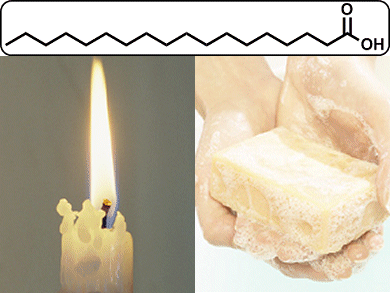Michel Eugène Chevreul was born in Angers, France, on August 31, 1786. In 1803, he moved to Paris to work in the laboratory of Vauquelin, a chemist who discovered the elements chromium and beryllium, as well as discovering asparagine, the first amino acid to be isolated, and other naturally occurring compounds. In 1810, Chevreul was appointed as an assistant at the Museum of Natural History and in 1813 he took on his first teaching post as a professor of chemistry at the Lycée Charlemagne, Paris.
.jpg) Chevreul is best known for his research into fats, which had not been extensively studied before and thus with this work he opened up a new field of organic chemistry. He started his investigations by studying soaps and he elucidated that fats were combinations of acids with glycerin. In the course of this work, he discovered and isolated a large number of organic compounds, including fatty acids margaric, oleic and stearic acids, as well as valeric, hexanoic, and decanoic acids (1813), hematoxylin (1808), cholesterol (1815), butyric acid (1818), creatine and hexadecanol (1832). These studies resulted in improvements in the manufacture of soaps and the replacement of tallow candles, which were soft and gave off unpleasant odors, with stearin candles. This started a new era in lighting.
Chevreul is best known for his research into fats, which had not been extensively studied before and thus with this work he opened up a new field of organic chemistry. He started his investigations by studying soaps and he elucidated that fats were combinations of acids with glycerin. In the course of this work, he discovered and isolated a large number of organic compounds, including fatty acids margaric, oleic and stearic acids, as well as valeric, hexanoic, and decanoic acids (1813), hematoxylin (1808), cholesterol (1815), butyric acid (1818), creatine and hexadecanol (1832). These studies resulted in improvements in the manufacture of soaps and the replacement of tallow candles, which were soft and gave off unpleasant odors, with stearin candles. This started a new era in lighting.
At this time, methods for studying organic compounds were not well developed, thus Chrevreul can be considered a pioneer of organic chemistry. In the course of studying fats, he established a systematic method for investigating organic compounds involving the extraction, isolation, and purification of organic compounds and he also established the use of melting points to determine the purity and identity of organic compounds.
In 1824, Chevreul became director of dyeing at the tapestry manufacturer Gobelins, Paris. Here, the recipes for the dyes were guarded secrets passed on from father to son. Chevreul was able to introduce a more scientific approach to the synthesis of dyes, thus improving the fastness and the brilliance of the colors. He also came up with laws that govern the contrast of colors.
Chevreul became professor of organic chemistry at the National Museum of Natural History in 1830, and thirty-three years later he was made director. He died in Paris on 9 April 1889, at the age of 102. He was given a public funeral and two years later a statue was erected in his memory at the Museum of Natural History.
Source
- Michel Eugene Chevreul (1786–1889),
Pierre. Lemay,
J. Chem. Educ. 1948, 25 (2), 62.
DOI: 10.1021/ed025p62
Michel Eugène Chevreul is the answer to Guess the Chemist (28).




